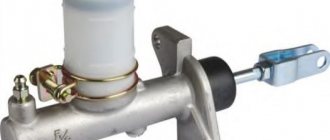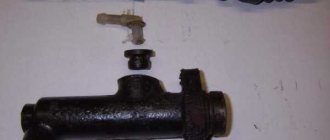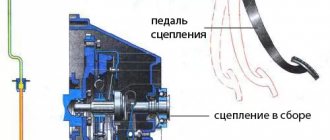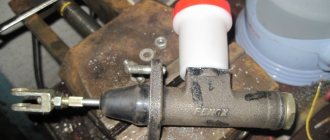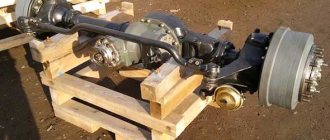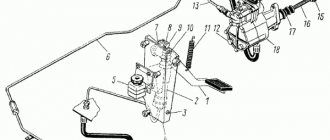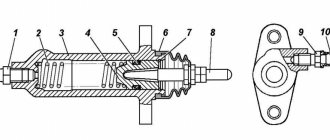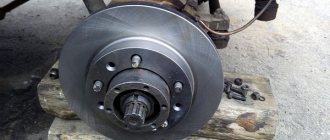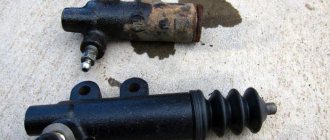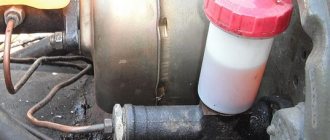The main malfunctions of the clutch and its drive are incomplete engagement (slipping of the clutch), incomplete disengagement (noise when shifting gears), disruption of the smooth engagement of the clutch and jamming in the clutch drive.
Incomplete engagement of the clutch, and as a result, its slipping under load, occurs when the pressure springs are weakened, there is no clearance between the thrust ring of the release levers and the end of the release clutch bearing, oiling and significant wear of the driven disks. To eliminate the malfunction, it is necessary to adjust the free play of the clutch release clutch, checking it against the free play of the clutch fork shaft lever, as indicated above.
If lubricant gets on the friction surfaces, there is severe wear or damage to the friction linings, it is necessary to remove the clutch from the engine and replace the friction linings or driven discs assemblies.
Promotional offers based on your interests:
Incomplete disengagement of the clutch (the clutch “drives”) leads to noise in the box when shifting gears due to the fact that the clutch release drive does not provide the required full stroke of the clutch fork shaft lever. To eliminate the malfunction, it is necessary to adjust the full stroke of the clutch fork shaft lever, as described above. Incomplete disengagement of the clutch also occurs when the driven discs are deformed or their hubs are jammed on the splines of the input shaft of the gearbox (front gear divider for the KamAZ-5320 vehicle).
The reason for incomplete disengagement of the clutch on KamAZ-5320 and KamAZ-4310 vehicles may be air entering the hydraulic drive system, leakage of working fluid, or increased free play of the clutch pedal. To eliminate the malfunction, it is necessary to: remove air from the hydraulic system using a bypass valve with a cap on the body of the pneumatic-hydraulic booster; check and eliminate leakage of working fluid; Check and, if necessary, adjust the free play of the clutch pedal. If a noise (squeaking) appears when you press the clutch pedal, this usually indicates a lack of lubrication or failure of the clutch release bearing.
Impaired smooth engagement, delayed engagement of the clutch when starting off and changing gears, jamming in the clutch drive are usually associated with swelling of the sealing cuffs of the hydraulic line and loss of tightness due to the use of low-quality working fluids, as well as the faulty operation of the follower device in the pneumatic-hydraulic amplifier.
When operating KamAZ vehicles in low temperature conditions, a significant increase in the viscosity (solidification) of the working fluid in the drive can occur, which impairs the performance of the drive. In these cases, it is necessary to replace the cuffs and fill the hydraulic drive system with clean Neva brake fluid, TU 6-09-550-73.
At the request of visitors to our site, we present the main problems that arise with KAMAZ clutches and describe troubleshooting methods.
These recommendations apply mainly to clutches of KAMAZ 5320, KAMAZ 53212, KAMAZ 5410, KAMAZ 54112, KAMAZ 55111, KAMAZ 55102, KAMAZ 53211, KAMAZ 53213 vehicles.
Possible KamAZ clutch malfunctions
Methods for identifying bridge faults
Typical faults
• Malfunction of the clutch drive (the clutch drive does not provide the required stroke of the clutch fork shaft lever).
Remedy: Check the serviceability of the clutch drive (air may enter the hydraulic system, leakage of working fluid, increased free play, etc.). Eliminate detected faults. • Warping of driven disks. Remedy: Straighten or replace driven disks.
Clutch drive jammed
• Swelling of the hydraulic clutch seals and loss of their tightness due to the use of non-recommended or contaminated brake fluids. Remedy: Replace the seals and flush the hydraulic system with clean brake fluid.
Delay in clutch engagement when starting the car and changing gears
• Solidification of the working fluid (increase in viscosity) in the clutch hydraulic system. Remedy: Wash and fill the shutdown drive hydraulic system with brake fluid.
• Jamming of the follower piston of the pneumatic booster. Remedy: Replace the cuff of the air booster follower piston.
• Seizures in the connections of the pins of the drive disks (pressure and middle) with the flywheel. Remedy: Grind and lubricate the surfaces of the studs in the connections between the discs and the flywheel.
Increased force on the clutch pedal (no gain)
• Lack of compressed air due to swelling of the inlet valve of the pneumatic booster. Remedy: Replace the valve.
• Jamming of the follower piston of the pneumatic booster due to swelling of the sealing collar or rubber ring. Remedy: Replace the cuff or ring of the follower piston.
• Wear or deformation of the air booster cuff. Remedy: Replace the cuff.
Noise in the clutch mechanism when it is disengaged
• Destruction of the clutch release bearing. Remedy: Replace the bearing.
• Increased runout of the thrust ring of the release levers. Remedy: Adjust the clutch mechanism in the device.
• Lack of clutch free play. Remedy: Adjust the free play of the clutch release clutch.
Buy spare parts from us:
Source
KamAZ 6522 mud mixer › Logbook › Eh, clutch! Don't brain me! — Part I, as it turned out...
))) It was with these words that I met another malfunction in the car. In fact, everything happened not so unexpectedly... From time to time I began to notice that the clutch was working intermittently: either the gear could not be caught, then after releasing the pedal it remained recessed, and the car started to move... I blamed the air in the system - no, the fluid level , the pedal is soft, no air was found during bleeding. It was another day of work transporting sand. The movement was carried out along a broken road in a line of loaded KAMAZ, MAZ, Volvo, etc. (from the loading place), then along a beautiful road near the city (M7 highway) and ended, again, on a broken road in the industrial zone (unloading place). Naturally, I had to use my feet on the pedals more often. Everything would be fine if not for one “but!” — after the second flight, my knee somehow started to hurt and I had to put more and more force on the clutch pedal, already resting my back on the seat! I arrived at a temporary base and, on the advice of knowledgeable “babaev”, began to remove the PSU for the purpose of repairing or replacing it. I looked, and the PGU is imported - German WABCO! We talked with the guys over a cup of tea and decided to take it apart and replace everything that was possible. A WABCO CCGT repair kit of Turkish licensed production was purchased (judging by the packaging) at a price of 950 rubles.
Possible malfunctions in the clutch mechanism of a KAMAZ vehicle and methods for elimination
The clutch may have the following main malfunctions: a violation of the drive adjustment, causing incomplete disengagement and unsmooth engagement of the clutch, slipping of the discs, wear of the friction linings of the driven disc, the clutch release clutch bearing, and the cuff of the clutch slave cylinder.
Slipping clutch discs
occurs when the pressure springs are weakened or broken, the friction surfaces of the flywheel and pressure plate are worn or warped, or the friction linings of the driven disk are oiled. Faulty pressure springs and oily friction linings are replaced with new ones. The friction surfaces of the flywheel and pressure plate are processed by grinding.
Incomplete clutch disengagement
appears as a result of increased pedal free play (with a mechanical drive) or a decrease in the piston stroke of the working cylinder (with a hydraulic drive), as well as due to deformation of the driven disk. The free play of the pedal is set during adjustment, and the defective driven disk is replaced with a new one.
Rough clutch engagement
is caused by wear of the driven disk linings, difficult movement of the driven disk hub, non-simultaneous pressing of the release bearing, and sticking of the clutch pedal on the axle. Difficulty moving the driven disk hub on the splines of the gearbox input shaft occurs due to the presence of nicks or burrs on the splines. The latter are cleaned and lubricated with a thin layer of graphite lubricant. Non-simultaneous pressing of the clutch release bearing onto the release levers is eliminated by adjustment. If the clutch pedal becomes stuck, clean the ends of the bushings from nicks and burrs and lubricate them.
During repairs, worn clutch release bearings are replaced with new ones. The driven and pressure disks, as well as pressure springs, depending on the condition, are restored or replaced. To carry out repair work, the clutch is disassembled using devices, one of which is shown in Fig. 3.1.
Clutch housing
and the cylinder block is not depersonalized during repairs. They are marked to prevent disassembly and to ensure alignment between the engine crankshaft and the transmission drive shaft. If these parts are impersonal, then after assembly the centering hole of the clutch housing is bored into the fixture.
The main defects of clutch housings are cracks, chips, breakage or wear of threads, wear of holes and supporting planes of the paws attached to the frame. Crankcases are rejected if cracks cover more than half the perimeter or pass through more than one hole for fastening bolts. Cracks in the clutch housing are welded. Chips that capture the hole are fused or welded to the chipped part of the part. If up to two threads are broken, it is restored by running a tap. If the thread has more than two threads broken or is worn out, then it is restored by cutting a thread of an increased repair size, installing a screwdriver or welding, followed by cutting a thread of a nominal size.
Why has the clutch pedal become stiff?
Since cable systems are the most prone to failure, let's first look at why the pedal might become stiff under these conditions:
- increased rigidity of the diaphragm spring petals - this leads to gradual wear of the part and its deformation;
- jamming of the release bearing, coupled with increased force to rotate the fork, subjects the clutch cable to increased loads;
- rupture of the cable wires - they adhere to the metal braid, increasing the resistance of the tight pedal.
The first reason is more common, and this is due to the arrangement of the petals of the basket. The central part, which has a release bearing, becomes higher than the plane of the spring; additional pressure is required to overcome this elevation.
To make the diaphragm spring more durable, manufacturers artificially increase the rigidity of the petals. This happens especially often with Chinese counterfeits of well-known companies. Despite expectations, the tight pedal will not change with the installation of such an element.
Repair of clutch parts
Defects in clutch parts and their elimination.
The clutch may have the following defects: slipping and incomplete disengagement of the discs, wear of the linings and the discs themselves, warping of the pressure plate, risks and cracks on it, loose fastenings, loss of elasticity of the springs, wear of the pedal axle bushings, etc.
Repair of clutch parts consists of replacing faulty parts with new ones, straightening them and welding cracks. If the thickness of the pressure plate is less than the nominal value, in addition to thermal insulating washers, metal spacers can be installed under the springs.
When replacing worn friction linings, they are riveted to the disk so that the heads of the rivets are buried in the linings by at least 1-1.5 mm. The driven disk with new linings is checked for runout using the transmission drive shaft as a mandrel.
Output from intermediate
Discs that have circular marks and burrs are leveled on a surface grinder, sometimes with preliminary turning on a lathe. If there is significant warping or cracks, the discs are replaced with new ones. The worn surfaces of the switch levers are fused with steel using gas or electric welding, and then processed according to a template and hardened.
How to save your clutch
In order for the clutch to last as long as possible, you must adhere to the following rules: at traffic lights and in traffic jams, turn off the speed and take your foot off the clutch pedal, when making shifts, release the gas pedal, do not move away abruptly, when the car is coasting, put the variable gear lever in neutral position and remove your foot from the clutch pedal, try not to use the car off-road or as a tow vehicle.
If you neglect these rules, then replacing the driven disc, and possibly the entire clutch, may be required much earlier. To check the wear of the driven disk, it is necessary to sharply press the accelerator in direct gear. If the engine “roars”, and the car is reluctant to accelerate, and a specific burning smell is felt, then this is the first sign that it is time to think about replacing the driven disk. Typically, once a clutch is burned, it will wear out completely within a couple of weeks.
What is the price
The purchase price of individual mechanisms is high, so it is better to adjust the clutch system by correcting the shortcomings of existing parts.
- A Euro 2 clutch disc, depending on the type, costs 1500-6000 rubles;
- shutdown fork included - RUB 3,860;
- piston group, depending on the manufacturer and brand of KamAZ - 6,000-25,000 rubles.
In order to perform clutch repairs infrequently, you need to regularly perform technical inspections and maintenance of the machine.
KamAZ and MAZ are cars that have gained particular popularity due to their exceptional reliability. They are used in literally all spheres of life - cargo transportation, construction, agriculture, and even off-road racing is often held on KamAZ trucks. Time-tested quality will not let you down if you operate the vehicle correctly and service the components and assemblies on time. Experts advise paying special attention to such procedures as adjusting the MAZ and KamAZ clutch. In case of any malfunctions, the KamAZ clutch basket is changed in a very short time. Let's figure out why the clutch of MAZ and KamAZ requires special attention.
Design and principle of operation
The operation of the mechanism is based on the principle of sliding friction force.
The KamAZ clutch device is used for:
- transfer of rotation from the crankshaft;
- gradual transfer of gears;
- reducing rotational vibrations;
- disconnecting the transmission device from the engine for a short moment.
In a car, gear shift occurs when the clutch pedal is depressed, there is no connection between the engine and the gearbox, and rotation is not transmitted.
The KamAZ leaf clutch consists of the following parts:
- a flywheel that receives rotation from the engine and transfers it to the gearbox through the basket;
- pressure plate complete with springs;
- drive disk assembly with linings and vibration damper;
- plug assembly that breaks the connection;
- an axial shaft to which rotation is applied;
- release bearing;
- spring that reduces vibrations;
- hood;
- structural linings located on the drive disk to reduce friction.
